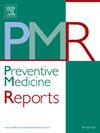Disparities in Tobacco use and cravings among sexual and gender minority adolescents in the United States
IF 2.4
3区 医学
Q2 PUBLIC, ENVIRONMENTAL & OCCUPATIONAL HEALTH
引用次数: 0
Abstract
Background
Despite well-documented disparities in tobacco use between sexual and gender minority (SGM) populations and their non-SGM counterparts, limited research has focused on tobacco cravings within these groups. This study examines tobacco use and tobacco cravings among SGM adolescents who are past 30-day tobacco product users in the United States.
Methods
Data were derived from the 2023 National Youth Tobacco Survey of high school students. Multivariable logistic regression analyses were conducted to examine the association between various SGM identities and tobacco use and cravings.
Results
Tobacco cravings were reported by 25.66 % of gay or lesbian, 34.63 % of bisexual, pansexual, queer, or asexual, and 19.09 % of other sexual minority adolescent tobacco users. Among gender minority users, 40.45 % of nonbinary, genderfluid, or genderqueer individuals and 20.34 % of other gender identities reported cravings. Compared to heterosexual users, the odds of cravings were higher among bisexual, pansexual, queer, or asexual (aOR = 4.35, 95 % CI = 2.12–8.94), gay or lesbian (aOR = 3.51, 95 % CI = 1.03–11.93), and other sexual identities (aOR = 2.79, 95 % CI = 1.16–6.71). Nonbinary, genderfluid, or genderqueer users had higher odds of cravings compared to cisgender boys or men (aOR = 3.64, 95 % CI = 1.63–8.13). Similarly, SGM adolescents had higher odds of current tobacco use than their non-SGM peers.
Conclusions
These findings highlight the significant disparities in tobacco cravings and use among SGM adolescents compared to their heterosexual counterparts. Programs targeting tobacco use and cravings among SGM youth will be beneficial.
求助全文
约1分钟内获得全文
求助全文
来源期刊

Preventive Medicine Reports
Medicine-Public Health, Environmental and Occupational Health
CiteScore
3.90
自引率
0.00%
发文量
353
 求助内容:
求助内容: 应助结果提醒方式:
应助结果提醒方式:


